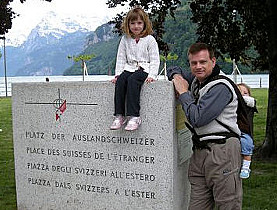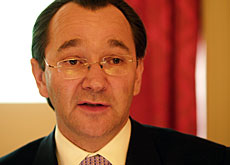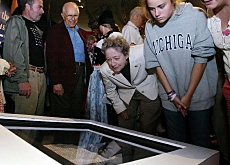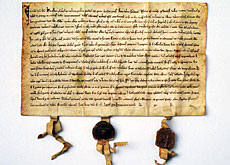Ancient charter wins American fans

Switzerland's Federal Charter made such an impact on one man when he saw it exhibited in the United States that he founded a society to promote it.
The pact signed by the forefathers of Switzerland in 1291 is the raison d’être of the International Bundesbrief Society, now celebrating its second anniversary.
This somewhat cosy club wants to make Switzerland’s founding document better known in the US and around the world.
Jim Scherrer vividly remembers the day that the artefact was presented to the American public at an exhibition at the National Constitution Center in Philadelphia. It was June 10 2006, and the first time the charter had left Swiss territory.
“I had the good fortune to be the first visitor to the exhibition and to see the charter alone,” Scherrer told swissinfo. It was a very moving experience for him.
“The people who created this document sacrificed a lot and created a marvellous country – Switzerland,” explained the Swiss-American, whose paternal grandfather emigrated to the US from canton St Gallen in 1922.
Spreading the word
Scherrer was so moved by the experience that he set up the International Bundesbrief Society the same day.
The organisation, based in Philadelphia, has taken on the mission to make the charter better known and to promote the influence of Switzerland in the area of democracy and constitutional law.
“The Bundesbrief was seen by many more people in 20 days in Philadelphia than in two years at the museum of Schwyz [in central Switzerland where it is normally kept],” Scherrer said. “And thanks to the exhibition of the charter in Philadelphia, visitor numbers in Schwyz increased from 7,000 to 10,000 per year.”
“The interest expressed, not only in the charter but also in the history of Switzerland and its principles of constitutional liberty and democracy, was so strong that we thought there was an opportunity there to forge links between the people who feel concerned about these subjects,” he added.
Chosen few
Two years later, the Bundesbrief Society, which recruits members on a selective basis, remains a “very closed” club, admits its founder and president. The society has just 50 members, in nine US states, Switzerland, Germany, Russia and Brazil.
“It’s a very closed association in the sense that we recruit our members solely by personal recommendation from someone who is already a member and in the sense that we don’t do mail shots by post or email. But we do plan to increase membership.”
Scherrer denies that the society has a reactionary slant because of the emphasis it puts on patriotism, a word which appears several times on the website.
“It’s possible that patriotism represents a feeling today that is purely American. But the importance we give it has sparked positive and confident reactions with regard to the depiction of Switzerland and its contribution to the world.
“We are not talking about patriotism with a negative, insular or ethnocentric connotation. On the contrary we think that patriotism is moving forward and is an integral part of a dynamic and energetic new millennium,” he explained.
The Bundesbrief Society reaches a greater public than its members alone. In February, it organised a performance of Richard Strauss’ Alpine Symphony by the Philadelphia Philharmonic, conducted by Charles Dutoit from Lausanne.
Reward
In a daring move, the Bundesbrief Society is offering a one million dollar reward to anyone who helps in the discovery and restitution of a copy of the federal charter, believed to be lost in the mists of time.
“We guarantee the payment of the reward through our members and our contacts in Switzerland,” Scherrer said.
Among its other projects, the society plans to put on an exhibition in Switzerland of the original copy of the US Declaration of Independence.
“The US and Switzerland are more than ever sister republics and their relations are stronger than ever,” Scherrer said referring to the 9/11 attacks and to similar political structures in both countries.
swissinfo, based on an article in French by Marie-Christine Bonzom in Washington
The Federal Charter is a written pact signed by the three small cantons that formed the core of Switzerland on August 1, 1291.
The charter forged an alliance of mutual protection between the cantons of Schwyz, Uri and Unterwalden against external threats, principally the Habsburg Empire at that time.
Some historians say the charter provides the basis for a democratic government and emphasis the power of the judiciary.
The document came after the English Magna Carta of 1215. But in contrast to the Magna Carta, the Swiss accord embraces democratic principles outside a monarchy.
It is not clear how many copies of the charter – written in Latin – existed and if some of them were lost.
The Museum of Schwyz exhibits the only copy – owned by canton Schwyz – that survived the test of time. The document travelled to Philadelphia under high security in 2006.
The International Bundesbrief Society was founded on June 10, 2006 in Philadelphia, the day the exhibition of the federal charter opened in that city.
The society aims to make the federal charter better known in the US and worldwide.
It also aims to encourage the development of constitutional democracy in countries where it is lacking.
Jim Scherrer, founder and president of the society is a Swiss-American born in the US in 1953. He heads an IT company in Philadelphia.

In compliance with the JTI standards
More: SWI swissinfo.ch certified by the Journalism Trust Initiative



You can find an overview of ongoing debates with our journalists here. Please join us!
If you want to start a conversation about a topic raised in this article or want to report factual errors, email us at english@swissinfo.ch.